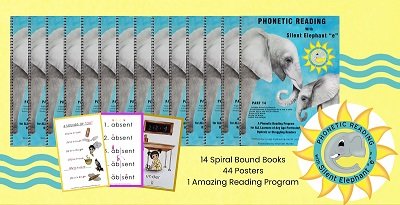Today I’d like to share more of my experiences with Phonetic Reading with Silent Elephant “e”® and continue my thoughts on why I am realizing it shouldn’t take 6 years for a child to be able to decode 6th grade reading words.
Over the last 12 years that I have taught reading, writing and spelling with Phonetic Reading with Silent Elephant “e”® it’s been my experience that children master phonemic awareness and learn all the phonics rules and are able to apply the phonics rules to fluently decode 6th grade words by the end of their 2nd grade year - about 8 years old. In other words, it takes about 2 years to achieve reading 6th grade words.
Further, Silent Elephant “e”® was written so this goal can be achieved with only 2 hours of instruction per week. Again, that’s what my data is showing because I only meet with my students for 2 hours a week. Of course, if they spend an hour per day learning with Silent Elephant “e”® , they will be decoding words at a 6th grade level even sooner.
Why would this be true? Why is this my experience over and over?
Well, they learn so easily and quickly because they are learning the way they learn best, through whole child/whole brain, multi-sensory activities and processes that stimulate all parts of their brain for both learning and retaining what they have learned. These whole child/whole brain, multi-sensory activities and processes are embedded into every moment of their instruction in Silent Elephant “e”®. My experience and data share the results.
I can hear some of you thinking, “But my child struggles with reading. It’s so difficult for him/her!”
If your child has a learning difference, multiple learning differences or any learning struggles, it may take longer for him/her to reach that 6th grade word recognition level.
But, you can rest assured that he/she will attain that level with Silent Elephant “e”® faster, more steadily and with more fun than with any other reading program. This is because they will be learning using all their senses (multi-sensory) therefore connecting their learning in all parts of their brain. In the case of dyslexic learners, it activates under stimulated parts of their brain and makes learning and retention of learning much easier.
This has been my experience with Silent Elephant “e”® : it may take children longer if they have learning differences, but they get there and they have fun getting there.
Let me share an example. I have been tutoring an ELL boy for 3 years who has multiple learning differences and speech and language processing disorders (one can barely understand his English or his native tongue). He is also considered to have an extremely low IQ.
When he came to me halfway through his 4th grade year, he wasn’t reading at all. He didn’t know letter sounds or letter names. He was illiterate and basically non-verbal.
Today as I write this, he has mastered phonemic awareness and knows all letter sounds and letter names. He has mastered the 700 High Frequency Fry Word List. He fluently reads simple to complex words, such as: so, ran, sphinx, squint, certain, cage, hurry. He reads words with single consonants, consonant digraphs and consonant blends, words with hard and soft “c” and “g”, words with long vowels, and words ending with “y”. He knows how to read and write (spell) words with the suffixes -s, -es, -ed, -ing, -er, -est, and -ly . He knows when to change or not change “y” to “i” and how to change “f” or “fe” to “v” when adding a suffix. Further, he is formulating answers to high level thinking questions.
When this beautiful boy, who has a goal of becoming a police officer, first came to me, his teachers were sure that he’d never learn to read.
That thought crossed my mind from time to time also when we first began, but I knew I couldn’t give up on this sweet, hard-working boy. He certainly isn’t giving up! Like I said, I knew he WOULD take longer than 2 years because of his learning differences and his language processing difficulties, but I had faith he would get there because of my experience with Silent Elephant “e”®. We started out very slowly and have slowly picked up speed.
He’s now reading early readers’ books. You should see the smile on his face as he shows me a book he’s read: one about veterinarians, one about astronauts, one about Ninjas, one about dinosaurs. He beams with pride! He is feeling the freedom and joy of reading.
His dad, who had been told his son would never read, says over and over to me, “You, Mrs. Jones, you are really teaching him to read!”
I humbly thank his dad and I think to myself that I’m so glad I wrote Silent Elephant “e”®. It has been the steady, consistent, multi-sensory instruction his son needs to understand language and learn to read.
From my experience with other students, I know that now that he’s almost finished with Part 10 of Silent Elephant “e”®, his reading growth will speed up! I can’t wait, I can already see his face beaming with both pride and relief. He realizes he is succeeding. He is feeling the joy of reading.
This fall he headed off into seventh grade with more of a feeling of confidence and that he has a future than he has ever felt. He’s still not reading on grade level yet, but he knows he is moving there, however long it takes.
























